First Drive: 2011 Mitsubishi RVR GT AWD
A cuter ute
Mitsubishi jumps into the mini-crossover ring
By John LeBlanc
LUNENBURG, Nova Scotia – My late father was a two-door kind of guy. So despite needing to jam my younger brother, myself, our hockey gear, and maybe even an occasional friend three or four times a week to a local rink or the requisite monthly road trip to some out-of-town tournament, Dad drove a steady stream of Ford Fairlane, Pontiac Ventura and Oldsmobile Cutlass two-door coupes, eschewing the more practical but not as cool image of a four-door sedan or – gawd forbid! – a station wagon.
Of course, today, no self-respecting parent would subject themselves (or their kids) to such an impractical ride. In the same way casual Fridays replaced three-piece suits and skirts, or nylon backpacks in lieu of brief cases, practical is cool. Well, up to a point, at least.
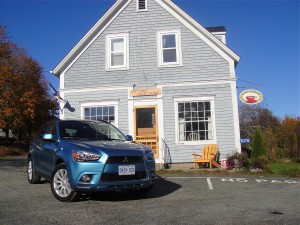 Which leads us to the new 2011 Mitsubishi RVR. With five doors, it’s obviously no Mazda Miata. But as the latest in the burgeoning niche-within-a-niche small compact crossover segment, like the also-new-for-2011 Nissan Juke, Hyundai Tucson, Kia Sportage and next spring’s Mini Countryman, the Mitsubishi is a lifestyle statement. It’s a new type of vehicle for buyers who don’t want to be lumped in with the mom ‘n dad image of the more practical Honda CR-V, Subaru Forester, Toyota RAV4 or Chevrolet Equinox, but need a bit more utility than Roger LeBlancs of the past would have had to forego.
Which leads us to the new 2011 Mitsubishi RVR. With five doors, it’s obviously no Mazda Miata. But as the latest in the burgeoning niche-within-a-niche small compact crossover segment, like the also-new-for-2011 Nissan Juke, Hyundai Tucson, Kia Sportage and next spring’s Mini Countryman, the Mitsubishi is a lifestyle statement. It’s a new type of vehicle for buyers who don’t want to be lumped in with the mom ‘n dad image of the more practical Honda CR-V, Subaru Forester, Toyota RAV4 or Chevrolet Equinox, but need a bit more utility than Roger LeBlancs of the past would have had to forego.
The RVR shares the same wheelbase but no body panels with Mitsubishi’s more conventional Outlander crossover. It’s also significantly smaller in all dimensions. Although the Outlander can be specced with a third row and seats for seven, the RVR is strictly a two-row, five-seater. Available in two trim levels and either front- or all-wheel drive, the RVR is also significantly less expensive than its big brother, right in line with its chief rivals. Whereas the Outlander starts at $25,498, the base 2011 RVR SE 2WD with a five-speed manual gearbox is $21,998. Standard kit is generous, including seven airbags, ABS with electronic brake-force distribution and brake assist system, stability control, traction control, hill-start assist, and Bluetooth hands-free with streaming audio and USB integration with voice control. A $1,200 continuously variable automatic transmission (CVT) is optional on 2WD models.
To get four-wheel traction in an RVR (that can be changed from 2WD to 4WD and full-on power-distribution lock via a console-mounted dial), you need to opt for the $24,998 SE 4WD trim, which also includes the mandatory CVT. The topline RVR GT 4WD adds magnesium steering-wheel paddles, rain-sensing wipers, a panoramic roof, high-intensity-discharge headlights, larger wheels and tires, and other details for $28,498.
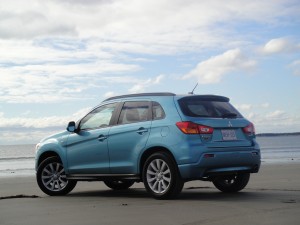 One look at the RVR and you can tell Mitsubishi designers took a more restrained approach than some of its rivals (i.e. the Juke). Its Lancer Evolution-inspired front end is balanced nicely with crisp lines and an overall perky stance. If a snobby German badge was stuck on the RVR’s front grille, people wouldn’t flinch. Inside it only gets better. Not trying to reinvent the wheel, the RVR continues with solid, driver-oriented ergonomics found in other small Mitsubishis. Only topline RVR GT 4WDs were available on the two-day media drive that had us winding back and forth along Nova Scotia’s scenic south shore Lighthouse Route. All RVRs benefit from a tilt and telescoping steering wheel, supportive and comfortable front seats and excellent fit and finish throughout. And compared to the Hyundai or Nissan competition, all-around outward visibility is excellent in the Mitsubishi, while the GT 4WD’s standard panoramic roof lightens up the interior even on a cloudy day.
One look at the RVR and you can tell Mitsubishi designers took a more restrained approach than some of its rivals (i.e. the Juke). Its Lancer Evolution-inspired front end is balanced nicely with crisp lines and an overall perky stance. If a snobby German badge was stuck on the RVR’s front grille, people wouldn’t flinch. Inside it only gets better. Not trying to reinvent the wheel, the RVR continues with solid, driver-oriented ergonomics found in other small Mitsubishis. Only topline RVR GT 4WDs were available on the two-day media drive that had us winding back and forth along Nova Scotia’s scenic south shore Lighthouse Route. All RVRs benefit from a tilt and telescoping steering wheel, supportive and comfortable front seats and excellent fit and finish throughout. And compared to the Hyundai or Nissan competition, all-around outward visibility is excellent in the Mitsubishi, while the GT 4WD’s standard panoramic roof lightens up the interior even on a cloudy day.
From a practical standpoint, all of the new Mitsubishi’s interior dimensions are competitive, except for width; it’s a bit narrow inside. The RVR offers a split, 60/40 rear bench with a pass-through in the middle that’s perfect for my younger daughter’s ringuette sticks. However its rear styling cuts down on cargo space. The Mitsu’s maximum cargo room (1,402 litres), while space behind the rear seats (614 L) is about 10 per cent smaller than its Korean rivals, although there’s considerably more on hand than in the tighter Nissan.
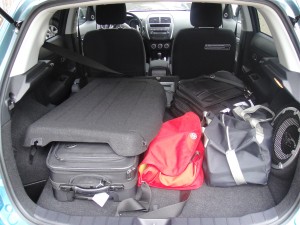 While the RVR and its ilk offer less cargo room than standard crossovers, they also sip less at the pumps. As Tomoki Yanagawa, Mitsubishi Motor Sales of Canada’s vice president of sales, marketing and corporate planning told the attending media, “While fuel prices have moderated from the highs of 2008 and 2009, Canadians still care about ongoing operating expenses and do consider fuel economy when choosing their next vehicle.” To that end, the RVR has been engineered to be light (with a 1,405 kg curb weight, it weighs considerably less than the Tucson, Sportage or Juke) and aerodynamic. The results are excellent: 8.4 L/100 km city and 6.6 L/100 km highway ratings for either 2WD or 4WD models when equipped with the CVT.
While the RVR and its ilk offer less cargo room than standard crossovers, they also sip less at the pumps. As Tomoki Yanagawa, Mitsubishi Motor Sales of Canada’s vice president of sales, marketing and corporate planning told the attending media, “While fuel prices have moderated from the highs of 2008 and 2009, Canadians still care about ongoing operating expenses and do consider fuel economy when choosing their next vehicle.” To that end, the RVR has been engineered to be light (with a 1,405 kg curb weight, it weighs considerably less than the Tucson, Sportage or Juke) and aerodynamic. The results are excellent: 8.4 L/100 km city and 6.6 L/100 km highway ratings for either 2WD or 4WD models when equipped with the CVT.
Unfortunately, the Mitsubishi’s frugality comes at a cost. The RVR only comes with a 148 hp and 145 lb.-ft. feet of torque, 2.0-litre inline-four gas engine. That’s about 30 to 40 horsepower and around 20 to 30 lb.-ft. less than its small crossover rivals. Despite its relatively light curb weight, with the RVR GT 4WD’s throttle matted on a highway onramp, it took over 11 seconds to get from zero to 100 km/h. Plus the appliance-like whine from the CVT makes a sound like a load of laundry on spin cycle. There is an option: If you agree that a good set of snow tires and some winter driver training beats AWD and all-seasons – and can live without the extra goodies – the base RVR SE 2WD with its five-speed manual may be worth a try.
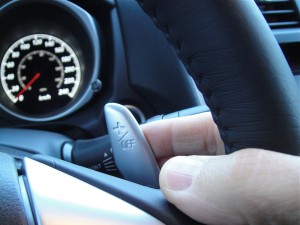 At least the GT’s standard paddle shifters help alleviate the CVT’s shortcomings. A bit. But Mitsubishi needs to offer an engine upgrade. By my estimation, moving to the more competitive (168 hp/167 lb.-ft.) 2.4-litre four found in other Mitsus would mean similar fuel economy ratings as the Tucson and Sportage, or about an additional $280 per year in fuel costs over the RVR’s 2.0-litre, based on 20,000 km/year of driving at a dollar per litre. As someone who enjoys driving, I’d pay the price. Especially because the rest of the RVR GT 4WD’s driving characteristics are decent.
At least the GT’s standard paddle shifters help alleviate the CVT’s shortcomings. A bit. But Mitsubishi needs to offer an engine upgrade. By my estimation, moving to the more competitive (168 hp/167 lb.-ft.) 2.4-litre four found in other Mitsus would mean similar fuel economy ratings as the Tucson and Sportage, or about an additional $280 per year in fuel costs over the RVR’s 2.0-litre, based on 20,000 km/year of driving at a dollar per litre. As someone who enjoys driving, I’d pay the price. Especially because the rest of the RVR GT 4WD’s driving characteristics are decent.
The RVR features slightly lower spring rates than the bigger Outlander, enabling a much smoother ride. When I was able to get it up to anything approaching illegal speeds, the electrically boosted power steering offered good feel and accurate responses. And unlike bigger crossovers such as the RAV4, the RVR GT 4WD with its large-ish 18-inch rubber cornered relatively flat and without too many vertical (head-bob) motions. Any attempt to accelerate out of corners with vigour, though, only incited the pouty CVT. It was cold enough, but it didn’t snow while we were in Nova Scotia. I did get to try the RVR’s all-wheel-drive capabilities on a couple of beaches, however, without any calls to CAA for a tow.
If you can accept the fact the new 2011 Mitsubishi RVR doesn’t live up to the performance halo cast by the brand’s all-conquering Evo street-legal rally car, overall, this small crossover offers a very attractive package for those who have grown out of their compact hatchbacks or don’t need the extra room of larger vehicles.
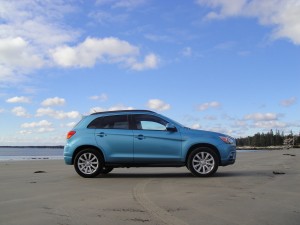 I’m not sure if my old man could have lived with the RVR 4WD’s annoying CVT or lack of performance. But the Mitsu’s styling is more mature than some of its current rivals. Its size and chassis make it a nimble drive, the interior feels like a premium piece of kit, it lives up to its fuel-efficient boasts and there’s loads of room for a couple of kids and their hockey gear. For the modern two-door kind of guy (or gal) looking for a fuel-efficient but practical compact vehicle, the new RVR deserves a look.
I’m not sure if my old man could have lived with the RVR 4WD’s annoying CVT or lack of performance. But the Mitsu’s styling is more mature than some of its current rivals. Its size and chassis make it a nimble drive, the interior feels like a premium piece of kit, it lives up to its fuel-efficient boasts and there’s loads of room for a couple of kids and their hockey gear. For the modern two-door kind of guy (or gal) looking for a fuel-efficient but practical compact vehicle, the new RVR deserves a look.
2011 Mitsubishi RVR
WHAT I LIKE: Driver-oriented and well-built cabin; better-than-average fuel economy; nimble size and handling, smooth ride, accurate steering
WHAT I DON’T: Glacial acceleration; CVT whine mars otherwise descent driving characteristics; rivals offer more cargo room
Base prices: $21,998 – $28,498
Type of vehicle: FWD or AWD five-door compact crossover
Engine: 2.0L, 16-valve DOHC I-4
Power: 148 hp
Torque: 145 lb.-ft.
Transmission: Five-speed manual (Opt. CVT; std. on AWD models)
Fuel consumption (AWD: city/hwy): 8.4/6.6 L/100 km
Competition: Jeep Compass, Kia Sportage, Nissan Juke, Mini Countryman, Toyota Matrix





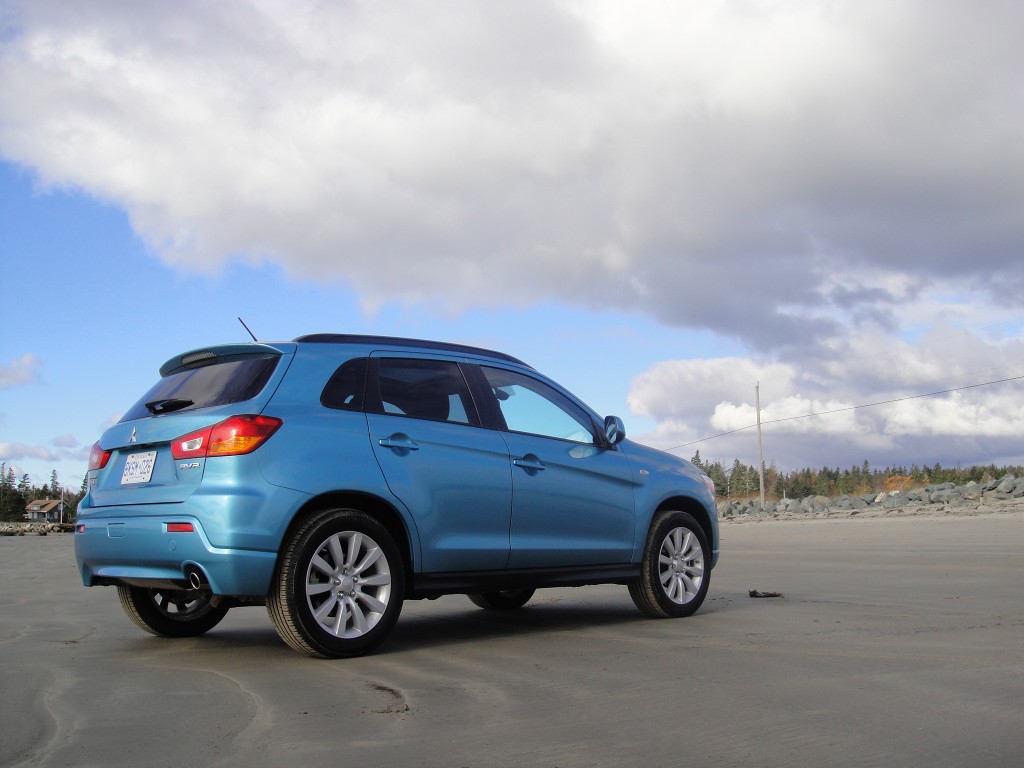
![[del.icio.us]](https://www.straight-six.com/wp-content/plugins/bookmarkify/delicious.png)
![[Digg]](https://www.straight-six.com/wp-content/plugins/bookmarkify/digg.png)
![[Facebook]](https://www.straight-six.com/wp-content/plugins/bookmarkify/facebook.png)
![[Google]](https://www.straight-six.com/wp-content/plugins/bookmarkify/google.png)
![[Reddit]](https://www.straight-six.com/wp-content/plugins/bookmarkify/reddit.png)
![[StumbleUpon]](https://www.straight-six.com/wp-content/plugins/bookmarkify/stumbleupon.png)
![[Twitter]](https://www.straight-six.com/wp-content/plugins/bookmarkify/twitter.png)
![[Email]](https://www.straight-six.com/wp-content/plugins/bookmarkify/email.png)